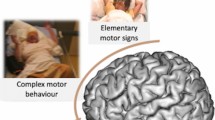Abstract
Central pattern generators (CPGs) are genetically determined neuronal aggregates in the mesencephalon, pons and spinal cord subserving innate motor behaviours essential for survival (feeding, locomotion, reproduction etc.). In higher primates CPGs are largely under neocortical control. We describe how certain motor events observed in parasomnias and epileptic seizures could have similar features and resemble motor behaviours, which can be the expression of the same CPG. Both epilepsy and sleep can lead to a temporary loss of control of neomammalian cortex that facilitates through a common platform (arousal) the emergences of stereotyped inborn fixed action patterns. Therefore we suggest that, independently from the nature of the trigger, be it a seizure or a parasomnia, the same CPGs can be involved, “caught up”, leading to a common motor semiology (the “Carillon theory”).
Similar content being viewed by others
Author information
Authors and Affiliations
Corresponding author
Rights and permissions
About this article
Cite this article
Tassinari, C.A., Rubboli, G., Gardella, E. et al. Central pattern generators for a common semiology in fronto-limbic seizures and in parasomnias. A neuroethologic approach. Neurol Sci 26 (Suppl 3), s225–s232 (2005). https://doi.org/10.1007/s10072-005-0492-8
Issue Date:
DOI: https://doi.org/10.1007/s10072-005-0492-8




